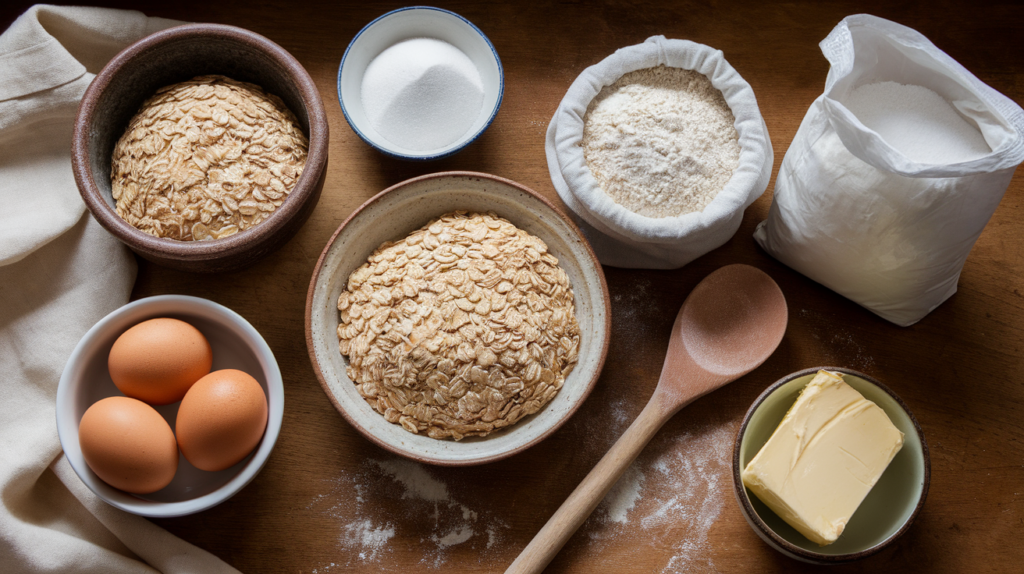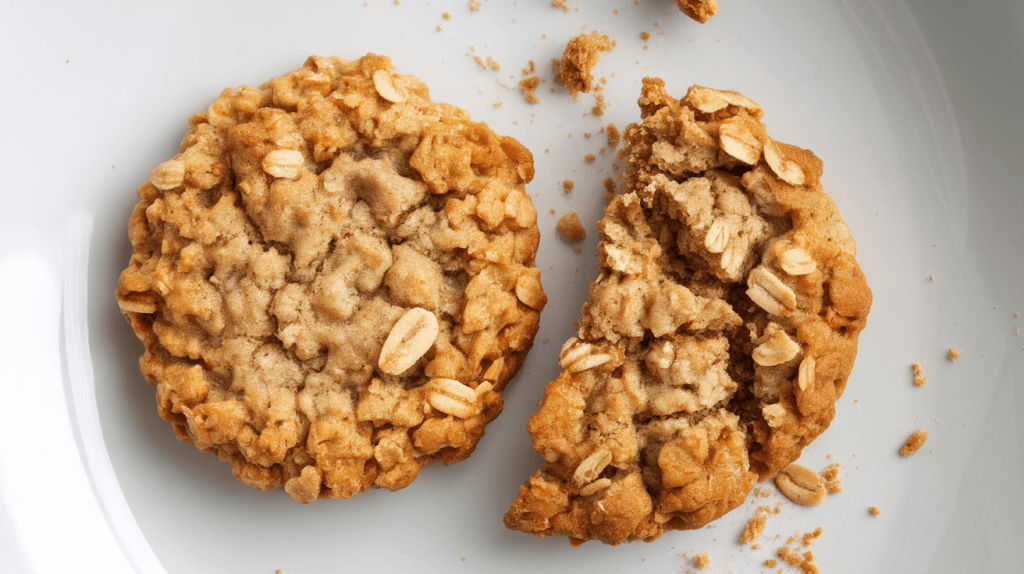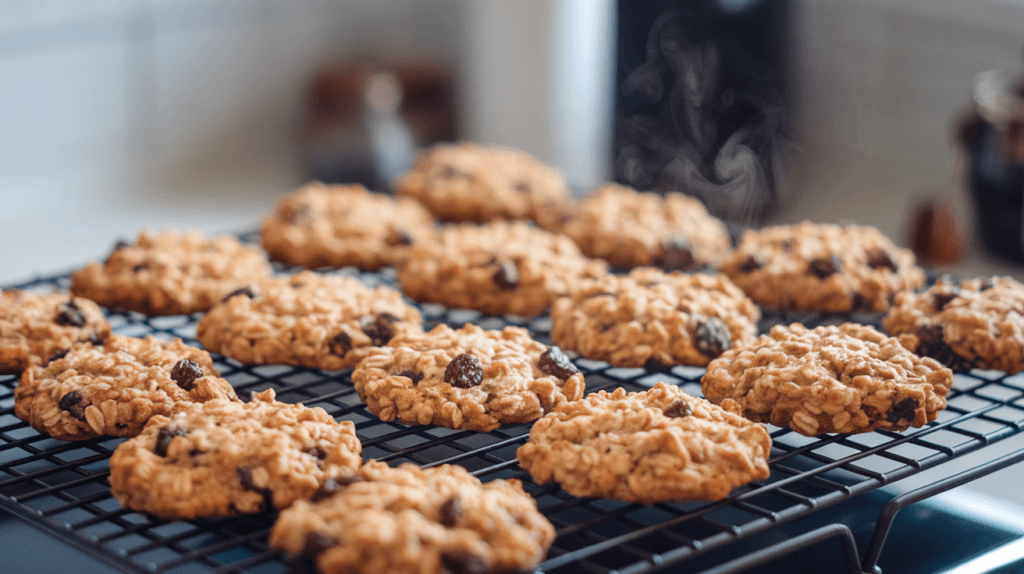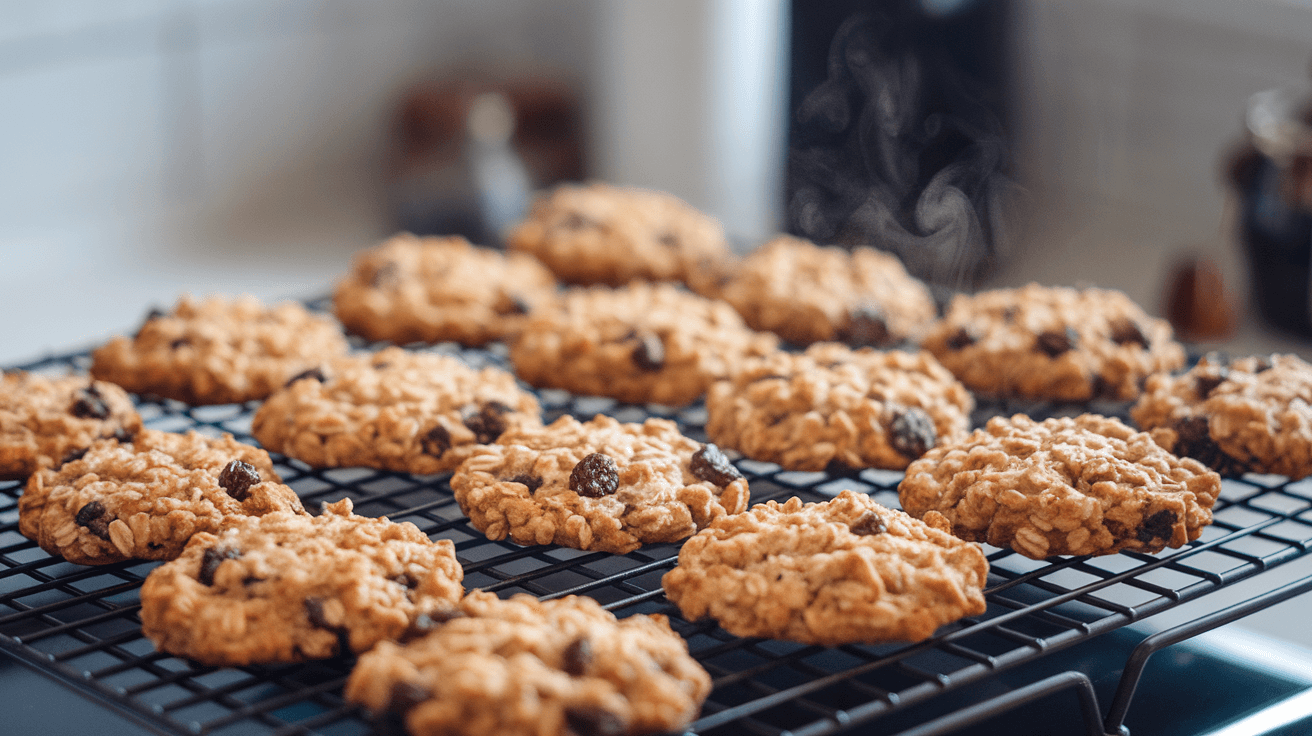Introduction
Oatmeal cookies are a classic treat beloved for their chewy texture, hearty flavor, and delightful sweetness. However, one of the most common complaints among bakers is, why do my oatmeal cookies crumble? This issue can be frustrating, as crumbling ruins the texture and structure of these beloved cookies.
Whether you’re a novice baker or an experienced one, understanding why oatmeal cookies crumble and learning practical solutions can help you avoid this common problem. By focusing on the right techniques and ingredients, you can ensure that your cookies turn out chewy, flavorful, and intact every time.
In this article, we will explore the most common reasons why oatmeal cookies crumble and share actionable tips to ensure your cookies turn out soft, chewy, and intact.
Understanding the Basics of Cookie Structure

To understand why oatmeal cookies crumble, it’s essential to grasp the basics of cookie structure. Every ingredient in a cookie recipe plays a specific role, and achieving the perfect balance is critical to their texture and stability.
Key Components of Oatmeal Cookies
Oatmeal cookies are made from a combination of fats, sugars, oats, flour, eggs, and leavening agents. Each of these components contributes to the cookie’s overall texture:
- Fats: Butter or shortening adds moisture and richness, helping to bind the dough.
- Sugars: Brown sugar contributes chewiness, while white sugar aids in crispness.
- Oats: The heart of oatmeal cookies, oats provide structure and flavor but can also cause crumbling if improperly balanced.
- Flour: Acts as a binding agent that holds all the ingredients together.
- Eggs: Essential for adding moisture and cohesiveness to the dough.
- Leavening Agents: Baking soda or powder provides lift, which influences the texture.
The Role of Each Ingredient in Binding
Binding is crucial for cookies to hold their shape and texture. For example:
- Flour: Too little flour results in a weak dough that falls apart, while too much makes cookies dry.
- Fats: Insufficient fat can make cookies brittle. Butter also helps trap air for softness.
- Eggs: They serve as the primary binding agent, keeping all ingredients intact.
If any of these ingredients are used in the wrong proportions, the cookies can become prone to crumbling.
Common Reasons Why Oatmeal Cookies Crumble

Crumbly oatmeal cookies can result from a variety of factors, ranging from ingredient proportions to baking techniques. Let’s explore the most common culprits behind this issue:
Insufficient Binding Agents
The absence or mismanagement of binding agents such as eggs, fats, or flour is one of the leading causes of crumbling. Eggs provide moisture and cohesiveness, while butter or shortening binds the ingredients together. If these are reduced in quantity, the dough won’t hold together effectively.
Overbaking
Baking oatmeal cookies for too long can dry them out, making them prone to crumbling. Overbaked cookies lose their moisture, leading to a brittle and fragile texture. Even a few extra minutes in the oven can make a significant difference.
Incorrect Mixing Methods
Improperly mixing the dough can also contribute to crumbling. Overmixing can incorporate too much air, which weakens the cookie structure. On the other hand, undermixing may leave the ingredients unevenly distributed, creating weak spots in the dough.
Imbalanced Ingredient Ratios
Oatmeal cookies require the perfect balance of dry and wet ingredients. Too much flour or oats compared to the liquid ingredients can make the cookies dry and crumbly. Similarly, adding too many mix-ins like nuts or raisins without adjusting the wet ingredients can disrupt the cookie’s structure.
Using the Wrong Type of Oats
Different types of oats absorb moisture differently. For instance:
- Old-Fashioned Rolled Oats: Provide structure but require precise balancing with liquid.
- Instant Oats: Absorb more moisture and can lead to a dry dough if not adjusted.
- Steel-Cut Oats: Often too coarse for cookies, contributing to a crumbly texture.
Skipping Resting Time
Allowing the dough to rest before baking helps hydrate the ingredients and stabilize the cookie structure. Skipping this step can make the dough less cohesive, leading to crumbling.
Ingredient Tips to Prevent Crumbling
Preventing crumbly oatmeal cookies starts with choosing and balancing the right ingredients. Here are practical tips to help you improve the texture and cohesiveness of your cookies:
The Importance of Fat (Butter or Shortening)
Fat plays a critical role in binding and moistening the dough. Here’s what you need to know:
- Butter: Provides a rich flavor and helps with binding. Make sure it’s softened but not melted for the best results.
- Shortening: Offers more stability than butter and can be used if you want a sturdier cookie.
- Combination: Using a mix of butter and shortening can balance flavor and stability, reducing crumbling.
Using the Right Amount of Flour
Flour acts as the glue that holds cookies together. However, using too much or too little can lead to issues:
- Measure Correctly: Use the spoon-and-level method to avoid packing too much flour into the measuring cup.
- Type of Flour: All-purpose flour is the standard choice, but substituting whole wheat or gluten-free flour may require adjustments in the recipe.
Choosing the Best Oats for Stability
The type of oats you use significantly impacts the texture of your cookies:
- Old-Fashioned Rolled Oats: These are ideal for oatmeal cookies, offering the right balance of structure and moisture absorption.
- Instant Oats: Absorb more liquid and can make cookies dry, so reduce the amount slightly if using these.
- Steel-Cut Oats: Typically not recommended for cookies as they are coarse and do not blend well into dough.
Incorporating Binding Agents
Binding agents such as eggs and certain liquid ingredients keep the dough cohesive:
- Eggs: Always use large eggs unless otherwise specified. Adding an extra egg yolk can increase binding power.
- Honey or Maple Syrup: Natural sweeteners can add moisture and improve cohesion in the dough.
Balancing Dry and Wet Ingredients
A proper ratio of dry to wet ingredients is crucial. Follow these tips:
- Keep the dough moist but not sticky.
- If adding mix-ins like chocolate chips or nuts, slightly increase the wet ingredients to maintain balance.
By carefully selecting and measuring your ingredients, you can minimize the risk of crumbly cookies and ensure a chewy, satisfying texture.
Ingredient Tips to Prevent Crumbling
Preventing crumbly oatmeal cookies starts with choosing and balancing the right ingredients. Here are practical tips to help you improve the texture and cohesiveness of your cookies:
The Importance of Fat (Butter or Shortening)
Fat plays a critical role in binding and moistening the dough. Here’s what you need to know:
- Butter: Provides a rich flavor and helps with binding. Make sure it’s softened but not melted for the best results.
- Shortening: Offers more stability than butter and can be used if you want a sturdier cookie.
- Combination: Using a mix of butter and shortening can balance flavor and stability, reducing crumbling.
Using the Right Amount of Flour
Flour acts as the glue that holds cookies together. However, using too much or too little can lead to issues:
- Measure Correctly: Use the spoon-and-level method to avoid packing too much flour into the measuring cup.
- Type of Flour: All-purpose flour is the standard choice, but substituting whole wheat or gluten-free flour may require adjustments in the recipe.
Choosing the Best Oats for Stability
The type of oats you use significantly impacts the texture of your cookies:
- Old-Fashioned Rolled Oats: These are ideal for oatmeal cookies, offering the right balance of structure and moisture absorption.
- Instant Oats: Absorb more liquid and can make cookies dry, so reduce the amount slightly if using these.
- Steel-Cut Oats: Typically not recommended for cookies as they are coarse and do not blend well into dough.
Incorporating Binding Agents
Binding agents such as eggs and certain liquid ingredients keep the dough cohesive:
- Eggs: Always use large eggs unless otherwise specified. Adding an extra egg yolk can increase binding power.
- Honey or Maple Syrup: Natural sweeteners can add moisture and improve cohesion in the dough.
Balancing Dry and Wet Ingredients
A proper ratio of dry to wet ingredients is crucial. Follow these tips:
- Keep the dough moist but not sticky.
- If adding mix-ins like chocolate chips or nuts, slightly increase the wet ingredients to maintain balance.
By carefully selecting and measuring your ingredients, you can minimize the risk of crumbly cookies and ensure a chewy, satisfying texture.
Baking Tips to Keep Cookies Intact

The baking process plays a critical role in determining whether your oatmeal cookies crumble or remain intact. From oven settings to cooling techniques, every step matters. Here are detailed tips to help you achieve perfectly baked cookies:
Optimal Oven Temperature
Baking at the correct temperature ensures your cookies bake evenly and hold their structure:
- Preheat the Oven: Always preheat your oven to ensure consistent baking. For oatmeal cookies, 350°F (175°C) is a standard temperature.
- Avoid High Temperatures: Baking at too high a temperature can cause cookies to dry out quickly and become crumbly.
- Use an Oven Thermometer: Ovens often have slight temperature variations. A thermometer ensures accuracy.
Proper Baking Time
The duration of baking affects both the texture and structural integrity of the cookies:
- Stick to the Recipe: Most oatmeal cookie recipes call for 10-12 minutes of baking. Adjust slightly based on your oven’s performance.
- Look for Visual Cues: Cookies should be golden brown at the edges but slightly soft in the center when removed from the oven. They’ll continue to set as they cool.
Use the Right Baking Surface
The type of baking sheet and liner you use can impact the cookies’ texture:
- Non-Stick Baking Sheets: Ideal for even heat distribution.
- Parchment Paper or Silicone Mats: These prevent sticking and promote even baking.
- Avoid Greasing: Greased surfaces can cause cookies to spread too much and lose their structure.
Cooling Methods to Prevent Crumbling
How you handle cookies after they come out of the oven is just as important as baking itself:
- Let Them Rest on the Sheet: Allow cookies to cool on the baking sheet for 5 minutes. This helps them firm up before transferring.
- Use a Wire Rack: Transfer cookies to a wire rack to cool completely, ensuring they don’t become soggy from trapped steam.
Batch Consistency
Ensure uniformity in cookie size and spacing for even baking:
- Portion the Dough: Use a cookie scoop or spoon to create equal-sized portions.
- Space Evenly: Leave about 2 inches of space between cookies to prevent them from merging or spreading excessively.
By following these baking tips, you’ll minimize the chances of your oatmeal cookies crumbling and achieve a perfect, chewy texture every time.
How to Fix Already Crumbly Cookies
If your oatmeal cookies have already turned out crumbly, don’t worry! There are several ways to salvage them and even repurpose them into delicious treats. Here are some effective solutions:
Quick Fixes for Crumbly Cookies
If your cookies are still soft or partially intact, try these fixes:
- Rehydrating with Steam: Place the cookies in a sealed container with a damp paper towel for a few hours. The moisture can help soften them and reduce crumbling.
- Microwave for Freshness: Wrap the cookies in a damp paper towel and microwave for 10-15 seconds. This can temporarily restore moisture and cohesiveness.
- Spread a Layer of Filling: Use peanut butter, frosting, or jam to bind crumbly cookies together into sandwich cookies.
Repurposing Crumbly Cookies
If the cookies are beyond saving in their original form, consider repurposing them into creative desserts:
- Cookie Crumble Topping: Crush the cookies into crumbs and use them as a topping for ice cream, yogurt, or pudding.
- Cookie Pie Crust: Mix the crumbs with melted butter to create a crust for pies or cheesecakes.
- Layered Parfaits: Layer the crumbled cookies with whipped cream, fruit, and chocolate for a quick and easy dessert.
- Milkshakes: Blend cookie crumbs with ice cream and milk for a delicious cookie milkshake.
Preventing Future Crumbling
After repurposing your cookies, take note of what might have gone wrong to avoid future mishaps:
- Check your ingredient measurements carefully, especially the ratio of wet to dry components.
- Ensure proper baking time and avoid overbaking.
- Let your dough rest and hydrate before baking.
When in Doubt, Start Fresh
If none of the fixes work, it might be best to start with a fresh batch, using the tips provided earlier in this article to ensure perfect cookies. Baking is a learning process, and even mistakes can lead to delightful new creations!
With these tips, you can turn crumbly oatmeal cookies into opportunities for creative desserts or ensure future batches come out perfectly chewy and delicious.
FAQs
Why do oatmeal cookies crumble more than other types of cookies?
Oatmeal cookies often crumble more because oats are coarser than flour and don’t bind as easily. Additionally, if the balance of wet and dry ingredients is off, the cookies are more prone to drying out and falling apart.
Can using gluten-free flour make oatmeal cookies more crumbly?
Yes, gluten-free flour can contribute to crumbling because it lacks the elasticity provided by gluten. To combat this, consider adding a binding agent like xanthan gum or an extra egg to help hold the dough together.
How does altitude affect the texture of oatmeal cookies?
At high altitudes, lower air pressure can cause cookies to spread more, making them thinner and prone to crumbling. Adjustments like adding slightly more flour or reducing sugar can help improve stability.
What type of oats should I use to prevent crumbling?
Old-fashioned rolled oats are the best choice for oatmeal cookies as they provide structure and absorb moisture effectively. Avoid using steel-cut oats, which are too coarse, or instant oats, which can dry out the dough.
How can I keep mix-ins like raisins or chocolate chips from causing crumbling?
Overloading your dough with mix-ins can disrupt its structure. Measure mix-ins carefully and slightly increase the wet ingredients, like butter or eggs, to compensate for the additional dry elements.
Is it necessary to chill oatmeal cookie dough to prevent crumbling?
Yes, chilling the dough can significantly reduce crumbling. Resting the dough allows the ingredients to hydrate fully and makes it easier to handle during shaping and baking.
Conclusion
Oatmeal cookies are a timeless treat, but their tendency to crumble can be frustrating. By understanding the role of each ingredient, mastering mixing and baking techniques, and using the tips outlined in this article, you can achieve soft, chewy cookies that hold their shape beautifully.
Remember, baking is as much about experimentation as it is about precision. Don’t be afraid to try new methods and adjust your recipes to suit your preferences. And if a batch doesn’t turn out as planned, repurposing those cookies can lead to delicious new creations.
Happy baking, and may your oatmeal cookies always turn out perfectly!

